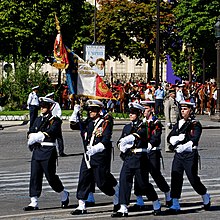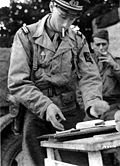|
Fusiliers marins
The Fusiliers marins (lit. "Sailor Riflemen") are specialized sailors of the Marine nationale (French Navy). The Fusiliers marins serve primarily as the Navy’s security forces, providing protection for naval vessels and naval installations on land. Created in 1856 and with a modern strength of about 1,800 personnel, the Fusiliers marins should not be confused with the larger Troupes de Marine of the Armée de terre (French Army) who are often referred to as the French ‘marines.’ MissionsThe Fusiliers marins are tasked with:
History of the French Fusiliers marinsCreation of a specialized corps in 1856These companies lacked specialized personnel trained for combat on land. An Imperial decree dated 5 June 1856, created the Fusiliers marins, whose formation and training were undertaken by a battalion stationed at Lorient, Brittany. This specialized corps was put under the command of the captains and sergeants-at-arms of the various naval vessels of the French fleet, and was the direct ancestor of the modern Fusiliers. Since that date, the Fusiliers have participated the following conflicts:
During the Franco-Prussian War of 1870, following the disaster of Sedan, several brigades of Fusiliers marins and naval artillerymen were engaged in combat at Bapaume and subsequently participated in the defense of Paris, notably at the Bourget and at L'Haÿ-les-Roses. This force formed part of the Government Armée versaillaise (French: armée versaillaise) employed in the suppression of the Paris Commune in 1871.  A detachment of Fusiliers marins defended the French Legation (diplomatic mission) in Peking during the Boxer Rebellion of 1900. Amongst their officers was enseigne de vaisseau Paul Henry and Pierre Alexis Ronarc'h, who, in 1914, would serve as Counter-Admiral and Commandant of the Brigade de Fusiliers Marins BFM attached to the 32nd Army Corps. The Brigade de Fusiliers marins distinguished themselves at Dixmude, on the Yser, at Longewaede, Hailles and Laffaux during the early stages of World War I. Three French ships have been named after Dixmude. The Fusiliers marins participated in the campaigns of Free France. They initially formed a battalion then the 1er Régiment de Fusiliers Marins 1e RFM at the corps of the 1st Free French Division (1er DFL) and the 1er Bataillon de Fusiliers Marins Commandos (1er BFMC) who served in 10 (Inter-Allied) Commando. The 177 Commandos Kieffer who disembarked on 6 June in Normandy, were Fusiliers Marins forming part of the Free France Forces. Other Fusiliers Marins, drawn from the former Armée de Vichy, formed the Régiment Blindé de Fusiliers-Marins (RBFM) which served efficiently as part of the 2nd Armored Division. On 30 April 1945 the Fusiliers marins played a role in the liberation of the Île d'Oléron. Disembarked at 0620 at Gatseau, an FM detachment advanced slowly through forested terrain facing stern resistance.  In 1945, the Far Eastern Marine Brigade (BMEO) was created with personnel from the RBFM and the 1er RFM, and was part of the French Far East Expeditionary Corps. The Marine Brigade formed riverine brigades (flottilles fluviales) in 1945–1946. They became the Dinassaut, which were created by General Leclerc in 1947 in order to replace the flottilles fluviales created by Jaubert, and operated in Tonkin and Cochinchina from 1947 to 1954. In 1956, with operational cadres serving in Algeria, the Demi-Brigade of Fusiliers Marins (DBFM) was created to play a leading role in securing the borders between Algeria and Morocco until 1962. This demi-brigade was under the command of Vessel Commander (CV) Ponchardier.
UniformsDuring the 19th and early 20th centuries the Fusiliers marins wore the standard dark blue or white uniforms of the French navy. When serving on land during the Franco-Prussian War and World War I the capotes (greatcoats) of the regular French infantry were adopted, together with leggings and leather campaign equipment. The Fusiliers marins retained their naval caps as distinctions, although the conspicuous red pompon was not worn in the field in 1914.[1] The modern Sailor Riflemen wear a dark blue beret with their combat uniforms, pulled right with their own distinctive badge worn over the left eye or temple. Along with the Naval Commandos, they are unique among French forces in wearing the beret this way. When wearing regular dress uniforms, the sailor cap is worn by junior ratings and the peaked cap by senior petty officers and officers.
EquipmentWeapons used Assault rifles Sniper rifles Shotguns
Pistols Non-lethal
Machine guns Rocket launchers
Inflatable boats
Ground vehicles
Notable Fusiliers marins
See also
Notes
References
External linksWikimedia Commons has media related to Fusiliers marins.
|
||||||||||||||||||||||||||||||||








